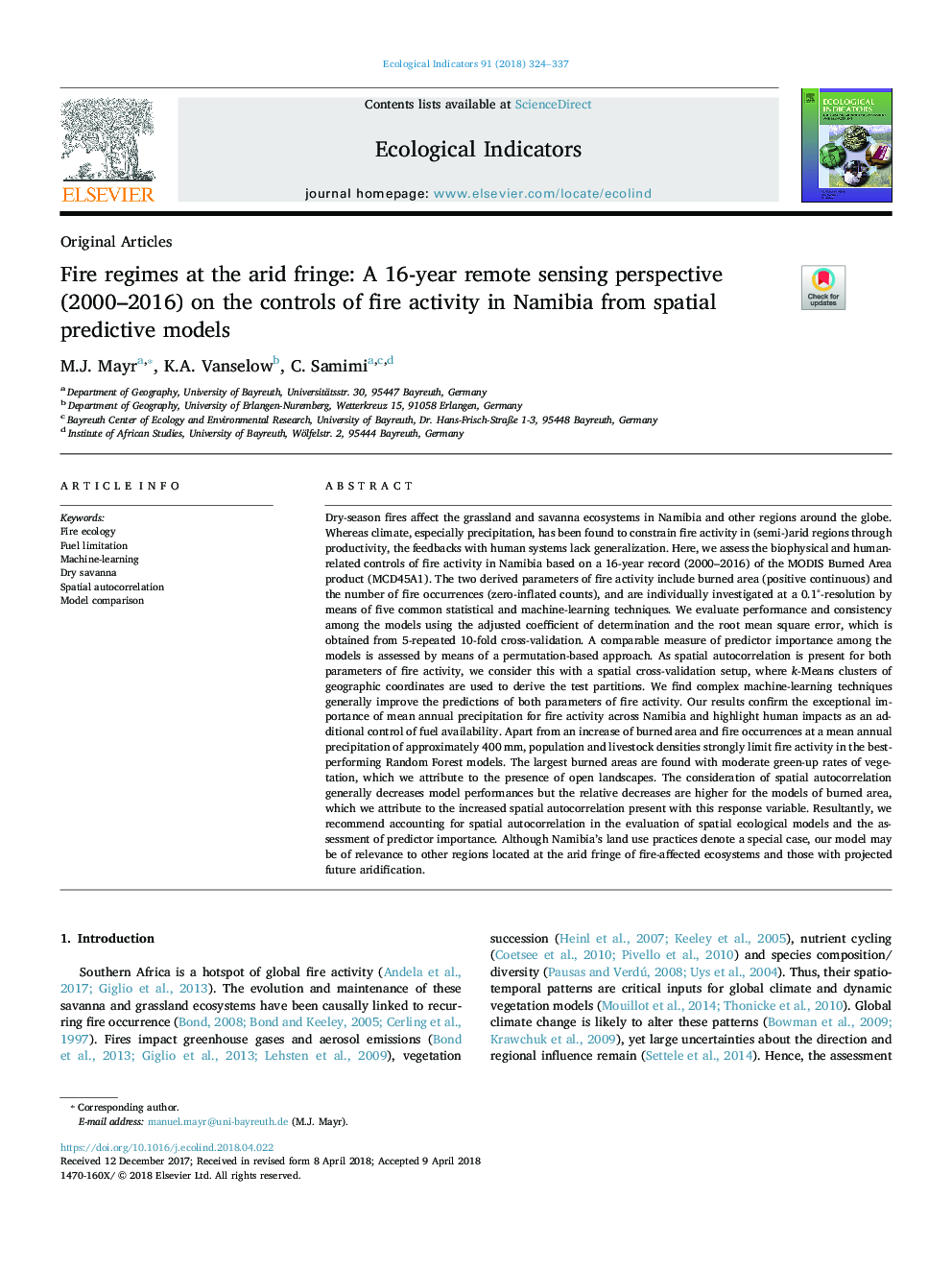| کد مقاله | کد نشریه | سال انتشار | مقاله انگلیسی | نسخه تمام متن |
|---|---|---|---|---|
| 8845332 | 1617111 | 2018 | 14 صفحه PDF | دانلود رایگان |
عنوان انگلیسی مقاله ISI
Fire regimes at the arid fringe: A 16-year remote sensing perspective (2000-2016) on the controls of fire activity in Namibia from spatial predictive models
ترجمه فارسی عنوان
رژیم های آتش سوزی در حاشیه خشک: چشم انداز سنجش از راه دور 16 ساله (2000 تا 2016) در کنترل فعالیت های آتش سوزی در نامیبیا از مدل های پیش بینی فضایی
دانلود مقاله + سفارش ترجمه
دانلود مقاله ISI انگلیسی
رایگان برای ایرانیان
کلمات کلیدی
اکولوژی آتش، محدودیت سوخت، فراگیری ماشین، خشک ساوانا، همبستگی فضایی، مقایسه مدل،
موضوعات مرتبط
علوم زیستی و بیوفناوری
علوم کشاورزی و بیولوژیک
بوم شناسی، تکامل، رفتار و سامانه شناسی
چکیده انگلیسی
Dry-season fires affect the grassland and savanna ecosystems in Namibia and other regions around the globe. Whereas climate, especially precipitation, has been found to constrain fire activity in (semi-)arid regions through productivity, the feedbacks with human systems lack generalization. Here, we assess the biophysical and human-related controls of fire activity in Namibia based on a 16-year record (2000-2016) of the MODIS Burned Area product (MCD45A1). The two derived parameters of fire activity include burned area (positive continuous) and the number of fire occurrences (zero-inflated counts), and are individually investigated at a 0.1°-resolution by means of five common statistical and machine-learning techniques. We evaluate performance and consistency among the models using the adjusted coefficient of determination and the root mean square error, which is obtained from 5-repeated 10-fold cross-validation. A comparable measure of predictor importance among the models is assessed by means of a permutation-based approach. As spatial autocorrelation is present for both parameters of fire activity, we consider this with a spatial cross-validation setup, where k-Means clusters of geographic coordinates are used to derive the test partitions. We find complex machine-learning techniques generally improve the predictions of both parameters of fire activity. Our results confirm the exceptional importance of mean annual precipitation for fire activity across Namibia and highlight human impacts as an additional control of fuel availability. Apart from an increase of burned area and fire occurrences at a mean annual precipitation of approximately 400â¯mm, population and livestock densities strongly limit fire activity in the best-performing Random Forest models. The largest burned areas are found with moderate green-up rates of vegetation, which we attribute to the presence of open landscapes. The consideration of spatial autocorrelation generally decreases model performances but the relative decreases are higher for the models of burned area, which we attribute to the increased spatial autocorrelation present with this response variable. Resultantly, we recommend accounting for spatial autocorrelation in the evaluation of spatial ecological models and the assessment of predictor importance. Although Namibia's land use practices denote a special case, our model may be of relevance to other regions located at the arid fringe of fire-affected ecosystems and those with projected future aridification.
ناشر
Database: Elsevier - ScienceDirect (ساینس دایرکت)
Journal: Ecological Indicators - Volume 91, August 2018, Pages 324-337
Journal: Ecological Indicators - Volume 91, August 2018, Pages 324-337
نویسندگان
M.J. Mayr, K.A. Vanselow, C. Samimi,
